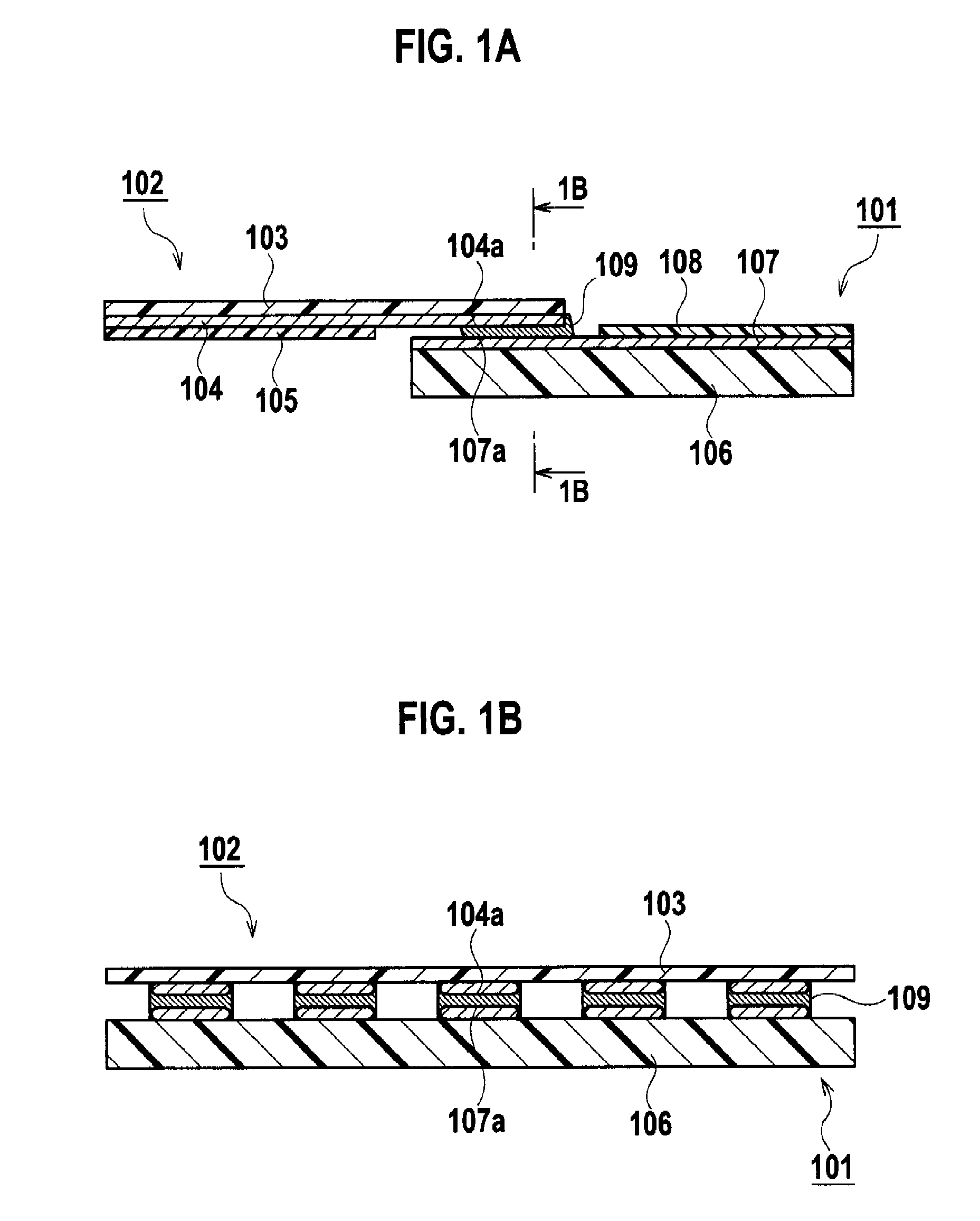Printed wiring board, method for forming the printed wiring board, and board interconnection structure
a technology of printed wiring and printed boards, applied in the direction of photomechanical equipment, originals for photomechanical treatment, instruments, etc., can solve the problems of reducing the miniaturization and weight of the connector parts, the cost of the connector parts is added to the total cost in the case of multi-signal connection, and the expense of the connector parts is difficult to miniaturize the connector parts having the fitting mechanism, etc., to achieve the effect of enhancing the connection strength and reducing the peeling strength
- Summary
- Abstract
- Description
- Claims
- Application Information
AI Technical Summary
Benefits of technology
Problems solved by technology
Method used
Image
Examples
first non-limiting embodiment
(Printed Wiring Board)
[0035]As shown in FIG. 2, a printed wiring board according to a first embodiment of the present invention includes an insulating layer 10, and conductive circuits 11 having, on end portions thereof, connection terminals 11a in each of which a width W1 of an upper surface is narrower than a width W2 of a bottom surface. FIG. 3 is a cross-sectional view of the printed wiring board viewed from a direction of a line 3-3 of FIG. 3.
[0036]As the insulating layer 10, for example, a flexible board such as a polyimide board, a polyethylene terephthalate (PET) board, and a polyethylene naphthalate (PEN) board can be used. Alternatively, as the insulating layer 10, for example, a hard rigid board such as a glass epoxy board, a glass composite board, and a paper epoxy board can be used. It is preferable that the insulating layer 10 have heat resistance to a temperature of a melting point of a solder or higher. In the case of using the rigid board as the insulating layer 10,...
second non-limiting embodiment
[0051]As shown in FIG. 5, a board interconnection structure according to a second embodiment of the present invention is different from that of FIG. 4, in the case of comparison therebetween, in that an upper surface width W3 of the connection terminals 13b is more narrow than a bottom surface width W4 of the connection terminals 13b of a second printed wiring board 2a. Other elements shown in FIG. 5 are substantially similar to those in the board interconnection structure shown in FIG. 4, and accordingly, a duplicate description will be omitted.
[0052]In accordance with the board interconnection structure according to the second embodiment, connection areas between the first insulating layer 10 and the first connection terminals 11a and between the second insulating layer 12 and the second connection terminals 13b are not reduced. Hence, the connection strengths between the first insulating layer 10 and the first connection terminals 11a and between the second insulating layer 12 an...
third non-limiting embodiment
(Printed Wiring Board)
[0056]As shown in FIG. 6, a printed wiring board according to a third embodiment of the present invention includes an insulating layer 10, conductive circuits 14 arranged on the insulating layer 10 and having connection terminals 15 on end portions thereof, and projection portions 16 provided on the connection terminals 15 in a direction where the conductive circuits 14 are extended. FIG. 7 is a cross-sectional view of the printed wiring board viewed from a direction of a line 7-7 of FIG. 6.
[0057]The insulating layer 10 is similar to that of the first embodiment.
[0058]The conductive circuits 14 form a circuit pattern of conductors, which are designed on the insulating layer 10. In the case of the pattern formation using the subtractive method, the conductive circuits 14 are formed by etching the rolled copper foil, the electrolytic copper foil, or the like on the insulating layer 10. Other metal foil than the copper foil is also usable as the conductors. For a ...
PUM
| Property | Measurement | Unit |
|---|---|---|
| thickness | aaaaa | aaaaa |
| thickness | aaaaa | aaaaa |
| thickness | aaaaa | aaaaa |
Abstract
Description
Claims
Application Information
 Login to View More
Login to View More - R&D
- Intellectual Property
- Life Sciences
- Materials
- Tech Scout
- Unparalleled Data Quality
- Higher Quality Content
- 60% Fewer Hallucinations
Browse by: Latest US Patents, China's latest patents, Technical Efficacy Thesaurus, Application Domain, Technology Topic, Popular Technical Reports.
© 2025 PatSnap. All rights reserved.Legal|Privacy policy|Modern Slavery Act Transparency Statement|Sitemap|About US| Contact US: help@patsnap.com



